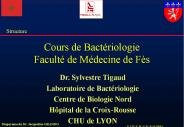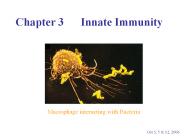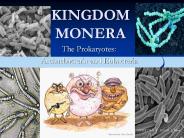Peptidoglycans PowerPoint PPT Presentations
All Time
Recommended
Glycoproteins and peptidoglycans
| PowerPoint PPT presentation | free to view
and Sialic acid (negatively charged) 2. Glycoproteins. Common core: 2 GlcNAc 3 Man ... Rich in sialic acid. Biological Roles of Glycans in Proteins ...
| PowerPoint PPT presentation | free to download
Cell walls of Eubacteria have peptidoglycans while those of ... Tooth decay. Lyme disease. Tetanus. Tuberculosis. Salmonella food poisoning. Pneumonia ...
| PowerPoint PPT presentation | free to view
Nocardia species Nocardia asteroides And many more Structure of an Acid Fast Cell Wall 3 major molecules: Peptidoglycans Contains N-glycolylmuramic acid instead ...
| PowerPoint PPT presentation | free to view
Importance m dicale la thermo-r sistance (les m thodes de st rilisation par la chaleur doivent tenir compte de cette propri t ) ...
| PowerPoint PPT presentation | free to download
Title: Neisseriae Neisseria gonorrhoeae Neisseria meningitidis Author: d partement Last modified by: Sylvestre Tigaud Created Date: 10/2/1998 10:05:42 PM
| PowerPoint PPT presentation | free to download
Classification of Organisms BIO 138 - Ch. 17 Ch. 17, section 1: Classification of Organisms -Taxonomy is the science of describing, naming, and classifying organisms ...
| PowerPoint PPT presentation | free to view
Title: Aucun titre de diapositive Author: grpa4375 Last modified by: user1 Created Date: 4/26/2004 3:04:28 PM Document presentation format: Affichage l' cran
| PowerPoint PPT presentation | free to download
Pourquoi les b ta-lactamines ont un spectre diff rent puisqu'elles agissent sur le m me site? Parce que les bact ries ont des PLPs diff rents ...
| PowerPoint PPT presentation | free to view
Starch is a mixture of amylose (unbranched) and amylopectin (branched every 25 sugars) ... Amylose and Amylopectin form helical structures. in starch granules ...
| PowerPoint PPT presentation | free to view
Follicle phase Ovulation. GN NDP. GP. P4, nmol/l. Foll. phase: 10 ... Follicular phase, day 7.9 0.6a 10.8 3.1ab 7.2 0.8b. Dominant follicle (DF) GN mastitis ...
| PowerPoint PPT presentation | free to view
Ch. 27: Bacteria and Archaea Modern/regular/eubacteria and the ancient methanogens Prokaryote cells with cell membranes, cytoplasm/cytosol, DNA in the form of one ...
| PowerPoint PPT presentation | free to view
Ch. 27: Bacteria and Archaea Modern/regular/eubacteria and the ancient methanogens Prokaryote cells with cell membranes, cytoplasm/cytosol, DNA in the form of one ...
| PowerPoint PPT presentation | free to view
These amino acids are mostly aromatic, uncommon and with D-stereochemistry. ... antibiotics differing only in the acetyl group of the acylglucosamine moiety. ...
| PowerPoint PPT presentation | free to view
food poisoning. S. aureus - infections. pyogenic infections ... S. aureus coag.- staph. b-hemolysis on BA - yellow pigmentation - coagulase - DNAse ...
| PowerPoint PPT presentation | free to view
Chapter 3 Innate Immunity Macrophage interacting with Bacteria Oct 3, 5 & 12, 2006 Cell Types of Innate Immunity Interleukin 1 (IL-1) Interleukin 6 (IL-6) Tumor ...
| PowerPoint PPT presentation | free to download
CLASSIFICATION, BACTERIA, AND VIRUSES Biology Virus Viral Infections can take place in two ways- Lytic infection Lysogenic infection Virus Lytic Infection The virus ...
| PowerPoint PPT presentation | free to download
The stereochemical relationships, shown in Fischer projection, among the D-aldoses with three to six carbon atoms. The stereochemical relationships among the D ...
| PowerPoint PPT presentation | free to download
... protein in an individual is much smaller than the potential antigenic repertoire. ... from a common primordial gene encoding the basic domain structure' ...
| PowerPoint PPT presentation | free to view
Bacterial Cell Structure and Function Lecture Cell Morphology Staphylococcus Diplococcus Streptobacilli Spirillum Spriochetes Bacterial Cell Structure and Function ...
| PowerPoint PPT presentation | free to view
Extreme thermophiles live in very hot environments (deep sea thermal vents) ... (b) Rod-shaped (bacilli) (c) Spiral. Prokaryote Metabolism ...
| PowerPoint PPT presentation | free to view
Mitochondria. Change chemical energy of molecules into the useable energy of the ATP molecule. ... Energy Processing Chloroplasts (Plants and algae) Mitochondria ...
| PowerPoint PPT presentation | free to view
2. Desulfovibrio sp oxidize acetic acid to CO2 using SO4-2 ... 4. Soil aerobic chemoautotrophs oxidize NH4 to NO3- Aerobic Photoautotrophs ...
| PowerPoint PPT presentation | free to view
starts as cytoplasmic membrane and eventually becomes cell wall ... FtsZ attach in a ring to the cell at the membrane and then attracts FtsA and Zip A ...
| PowerPoint PPT presentation | free to view
Pathogenesis is a multi-factorial process which. depends on the ... through the skin by a tick bite. Certain degradative exotoxins secreted by some bacteria ...
| PowerPoint PPT presentation | free to view
There are two main types of bacterial cell walls, Gram positive and Gram ... e. g. gastroenteritis, UTIs and neonatal meningitis. Salmonella. E.g. enteritis. ...
| PowerPoint PPT presentation | free to view
Antimicrobials Medicinal Chemistry Fall 2005 Antimicrobial Agents Antibiotics natural substances produced by microorganisms Semi-synthetic antibiotics ...
| PowerPoint PPT presentation | free to view
Methanogens obtain energy by using CO2 to oxidize H2 replacing methane as a waste. ... Sulfolobus oxidizes sulfur in hot sulfur springs in Yellowstone National Park. ...
| PowerPoint PPT presentation | free to view
A. Rod-shape. B. Round or spherical. C. Round in clusters. D. Round in twos. E. Spiral ... temperatures and others live in boiling hot springs and hot acids. ...
| PowerPoint PPT presentation | free to view
Prokaryotes And Eukaryotes All living organisms are classified into two broad categories, prokaryotes & eukaryote. Prokaryotes are those organisms whose cells lack a ...
| PowerPoint PPT presentation | free to view
Dermatologic: Rashes are common, ranging from photodermatitis to Stevens-Johnsons syndrome. ... Active against Pseudomonas, H. flu, M. cat. ...
| PowerPoint PPT presentation | free to view
CHAPTER 27. PROKARYOTES AND THE ORIGINS OF METABOLIC DIVERSITY ... Transmitted by the rat flea to humans, it caused the bubonic plague. Helicobacter pylori ...
| PowerPoint PPT presentation | free to view
... PUBLIC '-//Apple Computer//DTD PLIST 1.0//EN' 'http://www.apple.com/DTDs/PropertyList-1.0.dtd' ... xmlns:stRef='http://ns.adobe.com/xap/1.0/sType/ResourceRef ...
| PowerPoint PPT presentation | free to view
Biology material on Prokartotes
| PowerPoint PPT presentation | free to download
Ch. 19 Bacteria and Viruses
| PowerPoint PPT presentation | free to view
Sterilization (or sterilisation) refers to any process that eliminates, removes, kills, or deactivates all forms of life and other biological agents (such as fungi, bacteria, viruses, spore forms, prions, unicellular eukaryotic organisms such as Plasmodium, etc.) present in a specified region, such as a surface, a volume of fluid, medication, or in a compound such as biological culture media. Sterilization can be achieved through various means, including: heat, chemicals, irradiation, high pressure, and filtration. Sterilization is distinct from disinfection, sanitization, and pasteurization, in that sterilization kills, deactivates, or eliminates all forms of life and other biological agents which are present.
| PowerPoint PPT presentation | free to download
Download free PDF Sample@ https://bit.ly/3cdNiaT #ChemicalsAndMaterials #Chemicals #MarketAnalysis Sterile gamma-irradiated 70% isopropyl alcohol (IPA) is gamma-irradiated sterile IPA, which contains 70% USP-grade Isopropanol (Isopropyl Alcohol) and 30% USP-grade purified water.70% isopropyl alcohol is used for disinfection of hands and equipment surface and surgical devices. 70 % isopropyl alcohol solution kills microorganisms by dissolving the plasma membrane of the cell wall. Plasma membrane of gram negative bacteria consist of thin layer of peptidoglycan that easily destroyed by the alcohol
| PowerPoint PPT presentation | free to download
Bacteria Structure and Function Prokaryote & Eukaryote Evolution Cellular Evolution Current evidence indicates that eukaryotes evolved from prokaryotes between 1 and ...
| PowerPoint PPT presentation | free to download
Title: PowerPoint Presentation Last modified by: biochem2 Created Date: 1/1/1601 12:00:00 AM Document presentation format:
| PowerPoint PPT presentation | free to view
Microbiology. Prokaryote Architecture. Simple in shape, but genetically and biochemically advanced. General Prokaryote Shapes. Coccus round or spherical. Bacillus
| PowerPoint PPT presentation | free to download
Bacteria Structure and Function Prokaryote & Eukaryote Evolution Cellular Evolution Current evidence indicates that eukaryotes evolved from prokaryotes between 1 and ...
| PowerPoint PPT presentation | free to download
Title: Slide 1 Author: Suslow Last modified by: Admin Created Date: 1/4/2005 12:33:20 AM Document presentation format: (4:3) Company: UC Davis
| PowerPoint PPT presentation | free to view
Group streptococci Salmonella, Shigella. viridans streptococci some E. coli. Enterococcus sp. ... Salmonella (amoxicillin) or Shigella (ampicillin) infections ...
| PowerPoint PPT presentation | free to view
Archaebacteria and Eubacteria
| PowerPoint PPT presentation | free to view
Bacteria Prokaryotes are the most numerous organisms on Earth Prokaryotes Prokaryotes: are single-celled organisms that do not have a membrane-bound nucleus They live ...
| PowerPoint PPT presentation | free to view
Chapter 27 Prokaryotes and the Origins of Metabolic Diversity
| PowerPoint PPT presentation | free to view
Title: PowerPoint Author: Last modified by: APPLE Created Date: 9/5/2002 8:15:01 AM Document presentation format: (4:3)
| PowerPoint PPT presentation | free to view
Objectives E Describe the method of action that antibiotics take D Describe how antibiotic resistance arises in a population C Explain the difference ...
| PowerPoint PPT presentation | free to download
Escherichia coli LPS/O antigens, OMPs, flagella, peptidoglycan, inner membrane, DNA, ribosomes, tRNA, various protein assemblies
| PowerPoint PPT presentation | free to download
... Figure 4.13a Peptidoglycan in Gram-Positive Bacteria Figure 4.6 The Cell Wall Prevents osmotic lysis 4-7 Differentiate protoplast, spheroplast, and L form.
| PowerPoint PPT presentation | free to view
Chemistry Of Life: Carbon & Macromolecules Chapter 5
| PowerPoint PPT presentation | free to download
Ultrastructure of bacterial cell. Form and Function. Structure of a Prokaryotic Cell Bacterial Morphology and Ultrastructure Only two types of cells are produced by ...
| PowerPoint PPT presentation | free to download
KINGDOM MONERA The Prokaryotes: Archaebacteria and Eubacteria Methanogens These Archebacteria are anaerobes. They make methane (natural gas) as a waste product.
| PowerPoint PPT presentation | free to download
Bacteria Chapter 23 How to treat diseases Antibiotics fungi or bacteria that combat infection by interfering with various cellular functions May lead to ...
| PowerPoint PPT presentation | free to download
KEY CONCEPT Infections can be caused in several ways.
| PowerPoint PPT presentation | free to download
Characteristics of Living Things Living things are made of cells. Living things reproduce Living things are based on genetic code Living things grow and develop
| PowerPoint PPT presentation | free to download
























































